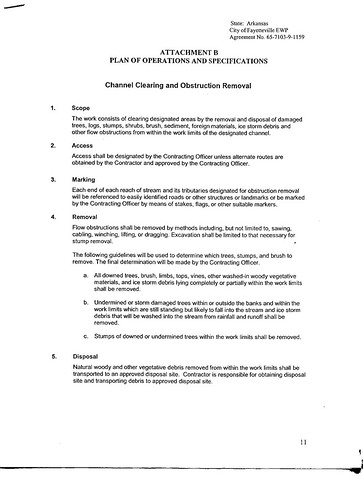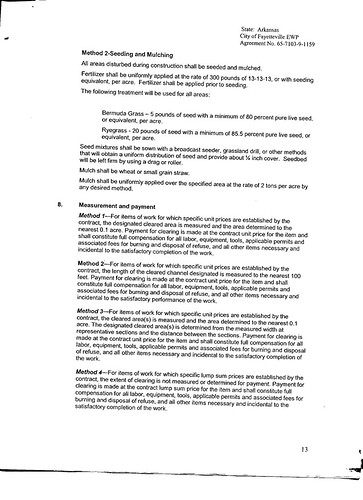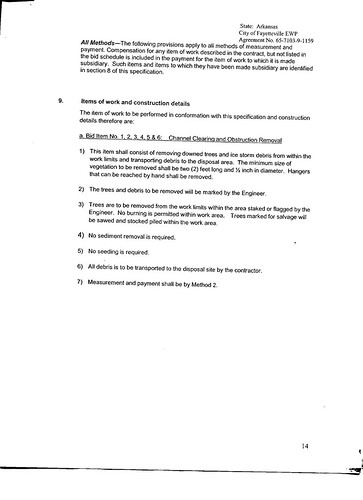
What part of NO don't these guys understand?
The living things in a half mile of this urban tributary of the West Fork of the White River were displaced and their habitat damaged for four days in November 2009 with no apology.
On the day that these photos were taken, the NRCS announced a huge effort to improve water quality in many states, including Arkansas. How does treating the riparian zones of Fayetteville's tributaries of the White River and the Illinois River watersheds make sense when the agency's overall mission includes protecting and enhancing such areas?
Release No. 0586.09
Contact:
Brad Fisher (202) 720-4024
SECRETARY VILSACK ANNOUNCES 41 WATERSHEDS TO TAKE PART IN MISSISSIPPI RIVER BASIN INITIATIVE
Initiative Will Provide Approximately $320 Million in USDA Assistance In Basin Area
WASHINGTON, November 23, 2009 - Agriculture Secretary Tom Vilsack today announced that 41 watersheds in 12 states, known as Focus Areas, have been selected to participate in a new initiative to improve water quality and the overall health of the Mississippi River Basin. The selected watersheds cover over 42 million acres, or more than 5 percent of the Basin's land area.
"The USDA is committed to working cooperatively with agricultural producers, partner organizations and State and local agencies to improve water quality and the quality of life for the tens of millions of people who live in the Mississippi River Basin, the Mississippi River Basin Healthy Watersheds Initiative will help" Vilsack said. "Today's announcement is another step toward achieving this goal, and I encourage as many eligible participants as possible to join us in this major conservation effort."
The Mississippi River Basin Healthy Watersheds Initiative (MRBI), which was announced on September 24, 2009, will provide approximately $320 million in USDA financial assistance over the next four years for voluntary projects in priority watersheds in Arkansas, Kentucky, Illinois, Indiana, Iowa, Louisiana, Minnesota, Mississippi, Missouri, Ohio, Tennessee and Wisconsin. MRBI will help producers implement conservation and management practices that prevent, control and trap nutrient runoff from agricultural land.
USDA's Natural Resources Conservation Service (NRCS) manages the initiative. NRCS State Conservationists from the 12 watershed states selected the watersheds with guidance from State Technical Committees and state water quality agencies. Selections were based on the potential for managing nitrogen and phosphorus -- nutrients associated with water quality problems in the Basin -- while maintaining agricultural productivity and benefiting wildlife.
Next, smaller watershed projects will be selected through a competitive process under NRCS' Cooperative Conservation Partnership Initiative (CCPI). NRCS assistance will be leveraged with contributions from partners, expanding the capacity available to improve water quality throughout the Basin.
Three requests for project proposals will be announced in the next several weeks, including one for CCPI. Funding for CCPI projects will come from NRCS' Environmental Quality Incentives Program, Conservation Stewardship Program and Wildlife Habitat Incentive Program.
Two other requests for proposals will fund projects through the Wetlands Reserve Enhancement Program and Conservation Innovation Grants. For information about these programs, visit www.nrcs.usda.gov/programs .
State(s) Watershed
Arkansas/Missouri - Cache
Arkansas - Lake Conway-Point Remove
Arkansas - L'Anguille
Arkansas/Missouri - Lower St. Francis
Illinois - Lower Illinois - Senachwine Lake
Illinois - Upper Illinois
Illinois - Vermilion (Upper Mississippi River sub-basin)
Illinois/Indiana - Vermilion (Upper Ohio River sub-basin)
Indiana - Eel
Indiana - Upper East Fork White
Indiana - Wildcat
Indiana/Ohio - Upper Wabash
Iowa - Boone
Iowa - Maquoketa
Iowa - North Raccoon
Iowa/Minnesota - Upper Cedar
Kentucky/Tennessee - Bayou De Chien-Mayfield
Kentucky - Licking
Kentucky - Lower Green
Louisiana - Mermentau
Louisiana/Arkansas - Bayou Macon
Louisiana/Arkansas - Boeuf River
Minnesota - Middle Minnesota
Minnesota - Root
Minnesota - Sauk
Mississippi - Big Sunflower
Mississippi/Louisiana/Arkansas - Deer-Steele
Mississippi - Upper Yazoo
Missouri/Iowa - Lower Grand
Missouri - North Fork Salt
Missouri - South Fork Salt
Missouri/Arkansas - Little River Ditches
Ohio/Indiana - Upper Great Miami
Ohio - Upper Scioto
Tennessee - Forked Deer
Tennessee/Kentucky - Obion
Tennessee - South Fork Obion
Tennessee/Kentucky - Red River
Wisconsin/Illinois - Sugar
Wisconsin/Illinois - Upper Rock
Wisconsin/Illinois - Pecatonica
For information about the Mississippi River Basin Healthy Watersheds Initiative, including eligibility requirements, please visit the MRBI web page at http://www.nrcs.usda.gov/programs/mrbi/mrbi_overview.html or your USDA Service Center. A map of the project area is available the MRBI Programs webpage.
Subscribe to NRCS news releases and get other agency information at http://www.nrcs.usda.gov or contact NRCS Public Affairs at 202-720-3210.
NRCS celebrates its 75th year of service in 2010.
USDA is an equal opportunity provider, employer and lender. To file a complaint of discrimination, write: USDA, Director, Office of Civil Rights, 1400 Independence Ave., S.W., Washington, D.C. 20250-9410 or call (800) 795-3272(voice), or (202) 720-6382 (TDD).




